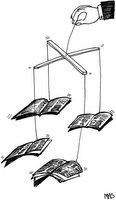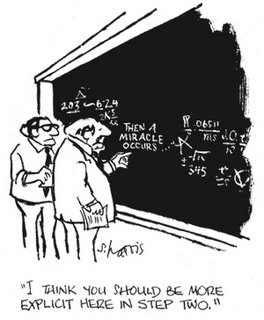21.5.06
20.5.06
introducing our new contributor
Are medical Journals an extension of the marketing arm of pharmaceutical companies?
 According to some people in the field modern medical journals are not more then a marketing machine for the pharmaceutical companies. In a recent essay by Richard Smith gives his view on this matter.
According to some people in the field modern medical journals are not more then a marketing machine for the pharmaceutical companies. In a recent essay by Richard Smith gives his view on this matter."The most conspicuous example of medical journals' dependence on the pharmaceutical industry is the substantial income from advertising, but this is, I suggest, the least corrupting form of dependence. The advertisements may often be misleading and the profits worth millions, but the advertisements are there for all to see and criticise."
Pharmaceutical companies trying to influence professionals in the medical field exposing their sponsored trials in highly respected medical journals.
"For a drug company, a favourable trial is worth thousands of pages of advertising, which is why a company will sometimes spend upwards of a million dollars on reprints of the trial for worldwide distribution. The doctors receiving the reprints may not read them, but they will be impressed by the name of the journal from which they come. The quality of the journal will bless the quality of the drug."
Although questionable, this still wouldn't be a problem. However these sponsored trials rarely show results that are unfavourable to the companies' products. Paula Rochon, analyzing the trial results funded by manufacturesr of nonsteroidal anti-inflammatory drugs for arhtritis. All the 56 trials published showed the company's drug to be as good as or better then the comparison treatment.
"The evidence is strong that companies are getting the results they want, and this is especially worrisome because between two-thirds and three-quarters of the trials published in the major journals—Annals of Internal Medicine, JAMA, Lancet, and New England Journal of Medicine—are funded by the industry"
How are companies able to get the results they want from clinical trials? Smith gives us some examples. Ofcourse, fiddling with the results would be far to obvious. The right results can however be obtained by asking the "right" questions. For example a trial can be conducted of your drug against a treatment known to be inferior, or to dose your drugs against a too low a dose of a competitor drug. etc. Some suggestions made to prevent the journals from being a marketing tool for the pharmaceutical industry:
"Editors can review protocols, insist on trials being registered, demand that the role of sponsors be made transparent, and decline to publish trials unless researchers control the decision to publish."
Smith, R. Medical Journals Are an Extension of the Marketing Arm of Pharmaceutical Companies. PLoS Medicine 2, e138 (2005).
nonverbal > verbal
"Albert Mehrabian found that the total impact of a message is about 7 per cent verbal (words only) and 38 per cent vocal (including tone of voice, inflection and other sounds) and 55 per cent non-verbal. Professor Birdwhistell made some similar estimates of the amount of non-verbal communication that takes place amongst humans. He estimated that the average person actually speaks words for a total of about ten or eleven minutes a day and that the average sentence takes only about 2.5 seconds. Like Mehrabian, he found that the verbal component of a face-to-face conversation is less than 35 per cent and that over 65 per cent of communication is done non-verbally."
from: Pease, A. Body language: how to read others' thoughts by their gestures, (Sheldon Press, 10th impression 1988).
18.5.06
trans-kingdom RNAi
 Some time ago I gave an introductional presentation to some of my collegues about the use of RNA interference to knockdown or silence genes. Back then the use of RNAi to knockdown certain genes was problematic since a solid way of delivering the RNAi to mammalian cells was not at hand. However since then alot of progress has been made...
Some time ago I gave an introductional presentation to some of my collegues about the use of RNA interference to knockdown or silence genes. Back then the use of RNAi to knockdown certain genes was problematic since a solid way of delivering the RNAi to mammalian cells was not at hand. However since then alot of progress has been made...Exciting progress has been made by Xiang and co-workers, non pathogenic Escherichia coli was engineered to produce short hairpin RNA (shRNA) targeting a mammalian gene, this to induce trans-kingdom RNAi in vitro and in vivo. The engineered E. coli strain induced, upon oral or intravenous administration, significant gene silencing in the intestinal epithelium and in human colon cancer xenografts in mice. "These results provide an example of trans-kingdom RNAi in higher organisms and suggest the potential of bacteria-mediated RNAi for functional genomics, therapeutic target validation and development of clinically compatible RNAi-based therapies".
Xiang, S., Fruehauf, J. & Li, C.J. Short hairpin RNA-expressing bacteria elicit RNA interference in mammals. Nat Biotechnol (2006).
and a great (short) review about the use of in vivo siRNA:
Xie, F.Y., Woodle, M.C. & Lu, P.Y. Harnessing in vivo siRNA delivery for drug discovery and therapeutic development. Drug Discov Today 11, 67-73 (2006).
15.5.06
Miracle

I saw this cartoon hanging on a collegues desk, without a doubt one of the funniest science cartoons I've ever seen. Many more science related cartoons can be found at the cartoon gallery of S. Harris, have fun!
(click on the image to enlarge (like with all images in this blog))
DNA origami
 Although a fascinating field of science, nanotechnology is not my cup of tea, however it gets alot more interesting when the use of DNA to create nanoscale structures is involved:
Although a fascinating field of science, nanotechnology is not my cup of tea, however it gets alot more interesting when the use of DNA to create nanoscale structures is involved:"DNA: it's not just for geneticists anymore. This has been a gradual realization over the past decade or so, as a small but growing cadre of nanotechnology-oriented researchers have begun working with the double helix as a building material for a variety of nanoscale structures. One such researcher, Paul Rothemund of the California Institute of Technology, got an early start in the field when, as an undergraduate in 1992, he undertook a project exploring the idea of DNA-based computing—a technology he continues to explore 14 years later"
"Precise molecular patterning is important for the design of higher-order DNA-based devices, but most techniques for building complex DNA structures require the laborious assembly of many small oligonucleotides in multiple reactions steps. A very recent alternative is the use of many short oligonucleotides to anchor a single, long "scaffold DNA" molecule into any of a variety of two-dimensional shapes, a process termed "DNA origami'
"A new twist for DNA" , Nature Methods 3, 333 (2006)
"Folding DNA to create nanoscale shapes and patterns", Rothemund PWK, Nature 440, 297-302 (16 March 2006)
14.5.06
Science and Fraud
What can journals, especially the well known journals who have alot of credibility to lose, do to detect fraud? Many editors are considering measurements to check for signs of misconduct in submissions, as can be read in the article "Detecting fraud at journals" published in The Scientist.
The Office of Research Integrity (ORI) has recently released some softwaretools to investigate questioned images. These educational tools illustrate several principles in examining questioned images. The software is free to download, and there is even an example journal available to try the tools on!
2.5.06
Indirect side effects of therapeutic trials may have led to organ failure.
Some time ago I wrote about Clinical trials of gene therapy in Cancer. Although promising alot remains to be investigated in this field, especially since the death of a 28-year-old patient, who participated in a gene-therapy trial based in Frankfurt:
"Scientists in Germany are trying to establish what exactly caused the death of a 28-year-old patient participating in a gene-therapy trial based in Frankfurt. He was one of three patients recruited so far to the trial, which aims to treat the rare but life-threatening immunodeficiency condition known as chronic granulomatous disease. He died on 10 April of septic shock, which caused his internal organs to fail.
Scientists reported the death at the annual meeting of the German Society of Internal Medicine on 26 April. The researchers say they think the death was not caused directly by the replacement gene given in the therapy, but they will investigate the question."
Link to the full newsarticle in Nature news
Palm Open source
or you want to show any date in Mayan hieroglyphics ? (yes very handy!) Don't look any futher!


